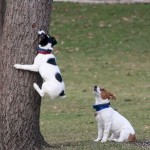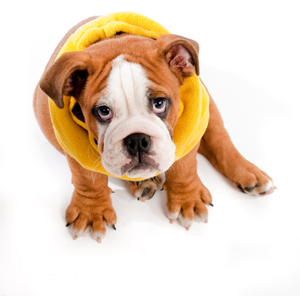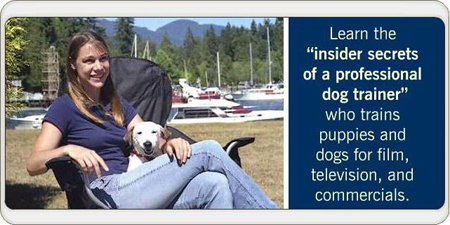Written by Senior Editor Peter Gehr
This is a subject that stinks, and, if you’re faced with dealing with it, I’ve compiled a list of the top 10 tips on how to stop a dog pooping in your yard. These tips are the result of talking to friends and neighbors, veterinarians, and gleaning the internet for useful and practical tips to help train your dog, or train your neighbors’ dog to do his business elsewhere.
If you are a dog owner, hopefully you already have an established regimen set up for your dog’s elimination needs. If someone in your neighborhood has a dog that habitually poops in your yard, on your lawn, or in some cases, right near the front step of your home or office, then this needs to be dealt with as soon as possible.
As per most issues with pets, this is not the dog’s fault. The dog is not maliciously dumping on your porch because he dislikes you. In his mind, it’s a matter of “when you gotta go, you gotta go,” and if he has not been trained or overseen when the call of nature arises, then this is the sole problem of the dog owner.
I’m going to first cite an example by telling you my story: I live in a condo and the entrance into the building is shared by 20 other condominiums. The courtyard is large and wide and allows for ample parking and entrance into each private garage. The front doors all face onto the courtyard/driveway. Several of our neighbors have dogs, and, for some reason, one of the dogs developed the habit of doing his early morning bowel movement right in front of my garage. It seemed like he picked the same spot every day, and it was early morning when no one was awake to catch the culprit in the act.
Rather than confronting all the dog owners in my neighborhood I wrote to the Body Corporate management. I also included a paragraph excerpted from the council bylaws in relation to dogs defecating in public and private property. I worded my complaint with humor, candor and also included a photo of a steaming feces.
The Body Corporate administrator sent a warning to all the dog owners pointing out that a fine will be incurred upon any dog owner allowing their pet to poop in the courtyard, and that complaints had been submitted.
The monetary “bite” seemed to get the attention of the responsible pooper, and problem solved.
To passively reinforce my request, I also sprinkled granules over the entire area in front of my garage door, and, so far, so good. I’ve re-sprinkled once each week and it definitely seems to work well.
Your situation may be entirely different, and this is why I’ve done some research to help you find a solution to pooping pooches.
Review on How to Potty Train a Puppy Video
Top 10 Tips On How to Stop a Dog Pooping in Your Yard
- Post a Sign. This will display to the offender that you are aware of the problem, and that you are taking steps to at least show your neighbor that you do not approve of your yard being a dog toilet. “Please Curb Your Dog” is a good one. You can also add the name of a security company to show that your yard may be monitored (even if it really isn’t). Try to find a professionally made sign. Responses to “home-made” signs can be negative.
- Odors Dog’s Dislike. Citrus oil, white vinegar, moth balls, or ammonia can be used to deter dogs. You will just have to be careful with these as they are not plant or grass friendly when they dissolve. Generally speaking, dogs also dislike the smell of garlic, pepper, chili, and even a soapy spray has been known to discourage dogs. Slow release odor granules are also available to either garden centers or pet stores.
- Gate, or fence. A fully fenced property simply keeps out unwanted dogs.
- Change Fertilizer: If you are using an animal based fertilizer on your lawn, chances are that the dog is responding to these odors and is attracted to your yard because of the organic matter on your lawn. A dog’s sensory perception is so incredibly acute that it may be able to smell it for miles.
- Sprinklers: Chances are that the offending dog is turning up at the same time each day. Program your sprinkler system to be on during that time, or, if the lawn is already wet, this will also act as an effective deterrent.
- Motion Sensor: Motion activated sprinkler systems can be a great choice. The dog will trigger the sensors and surprise the dog pre-poop, and will imprint a bad memory for the animal to stay away.
- Rosemary: Dogs dislike rosemary and this is a reasonably fast growing and pleasant looking plant.
- Plant Barriers: Roses or any thorny or course plants (such as holly) could be considered, but this is more of a long-term plan.
- Commercial Repellants: Sprays are available from your favorite pet store, and can be sprayed on pathways or garden edges.
- Eucalyptus and Tea Tree Oil: Make up a solution of eucalyptus oil or tea tree oil and spray it around the perimeter of your garden. Dogs detest this smell, and this could be enough to keep the animal away from your home.
I hope these top 10 tips on how to stop a dog pooping in your yard are a help in resolving this issue for you and your family. Remember, it’s not really the dog’s fault, and the dog owner should have better control over his dog. It’s quite possible that simply approaching the owner of the dog and communicating the problem will be the best solution, but this may not always be practical or possible.
If you want to try something natural, here’s a product called I Must Garden Dog and Cat Repellent Granules that is environmentally responsible.
Go to the Like button below and share with your Facebook friends. Thanks!













